| The gaming table : its votaries and victims, in all times and countries,
especially in England and in France. Vol. 2 | ||
TRICKS.
1. To tell a card thought of by a party after three deals. Take twenty-one cards of a pack, and deal them out one by one in three lots, requesting the party to think of a card, and remember in which lot it is.
Having dealt out the cards, ask the party in which lot the card is.
Take up the lots successively, and place the lot containing the card in the middle.
Deal out the cards again, and ask the party to state in which lot the card is; and proceed as before, placing the lot containing the card in the middle.
Deal out the cards in like manner a third time, proceeding as before.
Then deal them out as usual, and the eleventh card will be the one thought of, infallibly. This is the usual way of showing the card thought of; but, as the trick may be partly discovered by the counting, it is better to hold the cards in your hand, and take out the eleventh card, counting to yourself, of course, from the left hand, but pretending to be considering the guess.
This is apparently a most mysterious trick, although a necessary consequence of the position of the lot containing the card in the three deals.
2. The four inseparable kings.
Take four kings. Beneath the last place any two cards, which you take care to conceal. Then show the four kings and replace the six cards under the pack.
Then take a king and place it in the top of the pack, place one of the two other cards in the middle, and the other about the same place, and then, turning up the pack, show that one king is still at the bottom. Then let the cards be cut, and as three kings were left below, all must necessarily get
3. The barmaid and the three victimizers.
For this amusing trick you arrange the cards thus: Holding the pack in your hands, find all the knaves, place one of them next to your left hand, and the other three on the table. Then find a queen, which also place on the table. Then say: —
`Three scamps went into a tavern, and ordered drink. Here they are — the three knaves. "Who's to pay? I can't,'' said the first. "I won't,'' said the second. "I wish she may get it,'' said the third. "I'll manage it,'' said the first, the greatest rogue of the three. "I say, my pretty girl, haven't you some very old wine in your cellar?'' Here's the barmaid thus addressed by the rogue in question (showing the queen), and she replied: — "Oh yes, sir, prime old wine.'' "Let's have a bottle.'' [Off went the barmaid. Put the queen in your pocket.] "Now for it, my lads,'' said the knave in question; " `mizzle' is the word. Let's be off in opposite directions, and meet to-night; you
`When the poor barmaid returned [taking out the queen from your pocket] with the wine, great was her astonishment to find the room empty. "Lor!'' she exclaimed, "why, I do declare — did you ever! — Oh! but I'm not agoing to be sarved so. I'll catch the rogues, all of them — that I will.'' And off she went after them, as shown by placing her on, or at any rate, after the first.
`Now, to catch the three seemed impossible; but the ladies have always smiled at impossibilities, and wonders never cease; for, if you have the goodness to cut these cards, you will find that she has caught the three rogues.'
When the cards are cut, proceed in the usual way after cutting — not as required in the last trick; and taking up the cards, you will find the queen and three knaves together, which you take out and exhibit to the astonished audience.
Of course, one of these knaves is not one of the three first exhibited, but the one which you slipped on your left hand at first. There is no chance of
4. How to name every card in a pack successively turned up by a second party, and win every trick at a hand of Whist.
This is, perhaps, the most astonishing of all tricks with cards. Although it may be true that whatever puzzle one man invents, some other man may unravel, as before observed, I am decidedly of opinion that this trick defies detection. At the first blush it seems very difficult to learn; but it is simplicity itself in explanation.
Begin by laying out the cards in four rows according to the suits, all of a suit in a row side by side.
The cards must now be arranged for the trick. Take up the six in the top or bottom row, then the two in the next row, the ten in the third, and the nine in the fourth, placing them one upon the other in the left hand. Then begin again with the row from which you took the six, and take up the three. From the next row take the king. These numbers will be easily remembered with a little practice, amounting altogether to 30, made up thus — 6 and 2 are 8,
By repeating this addition a few times, it will be fixed in the memory.
Proceed by next beginning with the row next to the one from which you took the last card or the king, and take the eight; from the next row take the four; from the next the ace; from the next the knave. These cards make up 13. Therefore say, 8 and 4 are 12 and 1 are 13 — knave.
From the next row to that whence you took the knave, take the seven; from the next row take the five; from the next the queen. These cards make up 12. Thus, 7 and 5 are 12 — queen.
It thus appears that you have taken up thirteen cards consisting of the four suits, successively taken and being arranged as follows: — 6, 2, 10, 9, 3, king; 8, 4, 1, knave; 7, 5, queen.
Proceed in like manner with the remainder of the cards, beginning with the row next to that from which you took the queen, and take the six, then from the next row the two, and so on as before, making up another batch of 13 cards.
Repeat the process for a third batch, and finish with the remainder for the fourth — always remem
When the cards are thus arranged, request a party to cut them. This is only pretence; for you must take care dexterously to replace the cut just as it was before. Let them be cut again, and replace them as before. Your ruse will not be detected, simply because nobody suspects the possibility of the thing.
Now take up the pack, and from the bottom take the first four cards; handing the remainder to a party, sitting before you, saying — `I shall now call every card in succession from the top of the pack in your hand.'
To do this, two things must be remembered; and there is no difficulty in it. First, the numbers 6, 2, 10, 9, 3, king, &., before given; and next the suit of those cards.
Now you know the numbers by heart, and the suit is shown by the four cards which you hold in your hand, fan-like, in the usual way. If the first of the four cards be a club, the first card you call will be the six of clubs; if the next be a heart, the next card called will be the two of hearts, and so on
After a little private practice, you will readily and rapidly call, as the case may be, from the four cards in your hand: — the six of clubs, two of hearts, ten of diamonds, nine of spades, three of clubs, king of hearts, eight of diamonds, four of spades, ace of clubs, knave of hearts, seven of diamonds, five of spades, queen of clubs — and so on to the last card in the pack.
In the midst of the astonishment produced by this seemingly prodigious display of memory, say — `Now, if you like, we will have a hand at Whist, and I undertake to win every trick if I be allowed to deal.'
Let the Whist party be formed, and get the cards cut as usual — only taking care to replace them, as before enjoined, precisely as they were. Deal the cards, and the result will be that your thirteen cards will be all trumps. Let the game proceed until your opponents `give it up' in utter bewilderment.
This splendid trick seems difficult in description, but it is one of the easiest; and even were it ten times more difficult than it is, the reader will perhaps admit that it is worth mastering. Once committed to memory the figures are never forgotten, and a few repetitions, with the cards before you, will suffice to enable you to retain them.
5. Two persons having each drawn a card and replaced them in the pack, to guess these cards.
Make a set of all the clubs and spades, and another set of hearts and diamonds. Shuffle well each set, and even let them be shuffled by the spectators. Then request a person to draw a card from one of the sets, and another person to draw one from the second set.
You now take a set in each hand, presenting them to the two persons, requesting them to replace the drawn cards. You must pretend to present to each person the set from which he drew his card, but in reality you present the red set to the person who drew the black card, and the black set to the person who drew the red card.
Each person having replaced his card, you get each set shuffled. Then you take them in hand,
Of course you will have prepared the sets beforehand, and take care to alter the arrangement as soon as possible after the trick. But you can prepare the pack in the presence of others without their detecting it. Distribute the cards by dealing according to the two colours; take them up, and having placed the red set a little projecting over the black, set them down, and, pretending to cut them, separate the sets.
6. Twenty cards being arranged upon a table, a person thinks of two, and you undertake to guess them.
Lay out twenty cards of any kind, two by two,
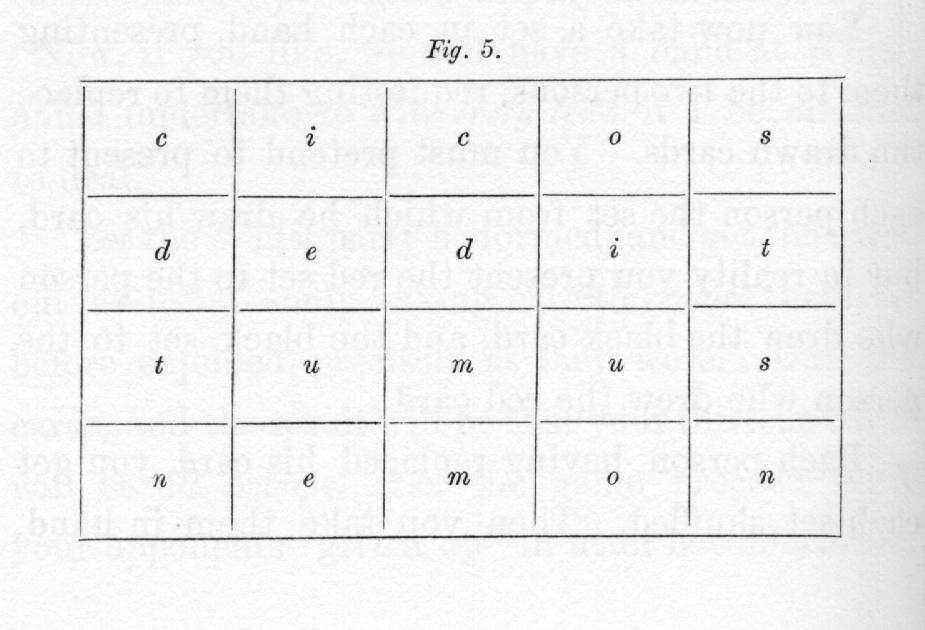
Fig. 5.
— — — — — — — — — — -
| c | i | c | o | s |
— — — — — — — — — — -
| d | e | d | i | t |
— — — — — — — — — — -
| t | u | m | u | s |
— — — — — — — — — — -
| n | e | m | o | n |
— — — — — — — — — — -
All the letters of the words being thus covered, ask the party who has thought of the cards to tell you in which lines these cards are. If both are in the first line (cicos), they must be those on the two c's; if they are both in the second line, they cover the d's in dedit; both in the third line, they cover the u's in tumus; both in the fourth, they cover the n's in nemon.
If one be in the first line and the other in the
7. To tell a card thought of without even looking at the cards.
Take any number of cards, — say twenty. Pretend to shuffle them with the faces towards you, and remember the first card as you close the pack — suppose the ten of diamonds. Tell the party that the only condition you require is to be told the order in which the card is dealt out by you; in other words, he must tell you whether in dealing it comes out first, second, third, &.
Remembering your first card, you may then turn your back to him, and deal out the cards one by one, and one upon the top of the other, requesting him to think of a card and its order as before said.
Then take up the cards, and shuffle them repeatedly, by throwing a portion of them from the bottom to the top, taking care not to mix the cards or let any drop, and then let the party cut them as often as he pleases. Then, take the cards in
The reason of this trick is simply that by merely cutting the cards, and shuffling them in the way indicated, you do not alter the sequence of the cards. With regard to this sort of shuffling, I may say that it is simply cutting the cards — always preserving their
This is the trick I alluded to at the commencement of the chapter, the mode of performing which I succeeded in discovering. Of course any number of persons may think of cards, remembering their order, and the operator will tell them, in like manner.
8. A person having thought of one of fifteen cards pre-sented to him, to guess the card thought of.
Form three ranks of five cards each, and request a party to think of one of these cards, and tell you in which rank it is. Take up the cards of the three ranks, taking care to place the cards of the ranks in which is the card thought of between those of the two other ranks.
Make three more ranks as before. Ask the
Observe, however, you must not form each rank with five consecutive cards; but you must place the cards one by one, placing one successively in each rank; thus, one at the top on the left of the first rank, one below that first for the second rank, one below the second for the third rank, then one in the first, one in the second, one in the third, and so on.
This trick, which is very easy, always produces a great effect. It only requires a little attention, and it can never fail unless you make a mistake in arranging the cards, which, however, is too simple to admit of error.
9. Two persons having each drawn a card from a pack, and having replaced them, to tell these cards after the pack has been shuffled and cut by the spectators as often as they like.
The cards may be easily divided into two numerical parts, even and odd: by taking a king
10. Singular arrangement of sixteen cards.
Take the four kings, the four queens, the four knaves, and the four tens of a pack, and ask if there be any one in the company who can form a square with them in such a manner that, taken in any direction, from right to left, from the top to
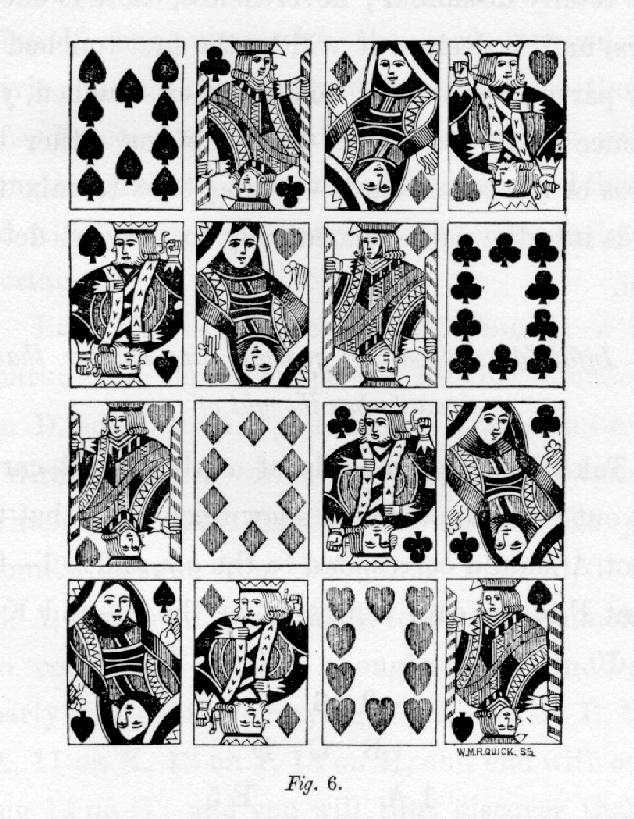
Fig. 6.
11. The seven trick.
Make up the four sevens of a pack, and take seven other cards, no matter which, for another lot, and, presenting both lots, you say: — Here are two lots totally dissimilar; nevertheless, there is one of seven, and I declare it will be the first touched by any party present. Of course, when touched, you at once prove your words by exhibiting either the sevens or the seven cards — taking care to mix the cards into the pack immediately to prevent detection.
12. Infallible method for guessing any number that a party has thought of.
Take the first ten cards of a pack of 52 cards. Set out
these ten cards as shown below, so that the point A should
correspond to the ace, and to 1 — the point F to the card
representing the 6 — and E to the 10.
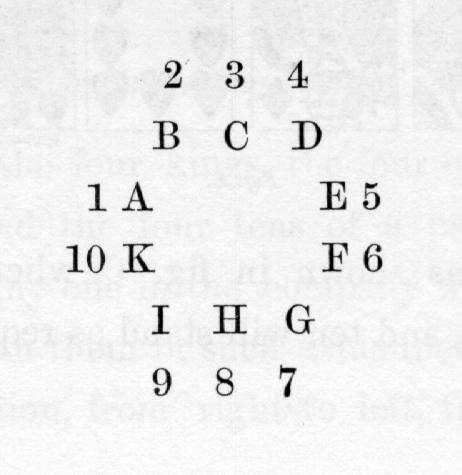 [Description: Layout of cards for the
"infallible method" described above.]
[Description: Layout of cards for the
"infallible method" described above.]
Thus prepared, you request a party to think of a card, and then you tell him to touch any number he pleases, requesting him to name it aloud. Then, adding the whole number of the cards to the number touched, you tell him to count backwards to himself, beginning with the card touched, and giving to that card the number of the one thought of. By counting in this way, the party will at length count the entire number on the card thought of, which you will thus be able to designate with certainty.
Example: — Suppose the card thought of is G. marking 7; again, supposing the one touched to be D, equal to 4; you add to this number the entire number of cards, which is, in this case, 10, which will make 14. Then, making the party count this sum, from the number touched, D to C, B, A, and so on, backwards, so that in commencing to count the number thought of, 7 on D, the party will continue, saying, 8 on C, 9 on B, 10 on A, 11 on K, 12 on I, 13 on H, and end with counting 14 on G; and you will thus discover that the number thought of is 7, which corresponds to G. Of course the party counts to himself, and only speaks to designate the point on which he stops,
Of course, the letters are only used to facilitate the explanation. The cards really form a sort of circle, beginning at 1 or the ace on the left, and then continuing with the 2, the 3, the 4, the 5, and so on, to the 10 below the ace; and, by necessity, the party must end his counting with the very card he thought of, beginning from the one he happens to point out.
13. The card that cannot be found.
Take any number of cards and spread them out fan-like in
your hand, as shown in fig. 7, faces fronting the spectators.
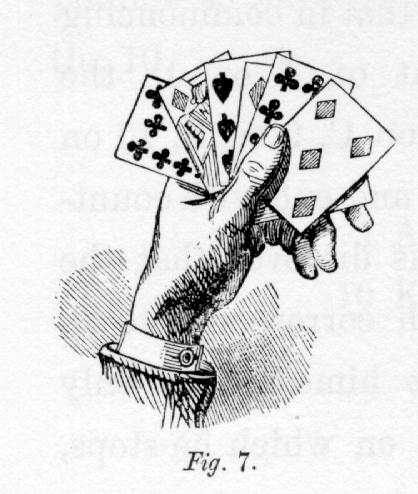
Fig. 7.
Ask one of them to select a card. You tell him to take it, and then to place it at the bottom of the pack. You hold up the pack, so that the specta
Then, pretending to take that card, you take the card
preceding it, and place it at a point corresponding to A in the
following figure.
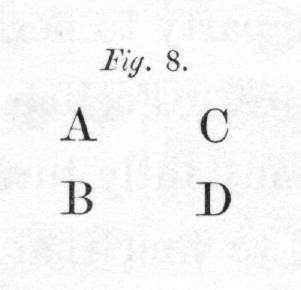
Fig. 8.
You then take the card drawn, namely, the king of hearts, and place it at the point corresponding to B in the above figure. Finally, you take any two other cards, and place them at C and D. Of course, the cards are placed face downwards.
After this location of the cards, you tell the party who has chosen the card that you will change the position of the cards, by pushing alternately that at the point A to B, and that at D to C, and vice versâ; and you defy him to follow you in these gyrations of the card, and to find it.
Of course, seeing no difficulty in the thing, and believing with everybody that his card is placed at the point A, he will undertake to follow and find his card. Then performing what you undertake to do, you rapidly change the places of the cards, and
Having thus arranged the cards for a few moments, you ask the party to perform his promise by pointing out his card. Feeling sure that he never lost sight of it, he instantly turns one of the cards and is astonished to find that it is not his own. Then you say: — `I told you you would not be able to follow your card in its ramble. But I have done what you couldn't do: here is your card!'
The astonishment of the spectators is increased when you actually show the card; for, having made them observe in the first instance, that you did not even look at the drawn card, they are utterly at a loss to discover the means you employed to find out and produce the card in question.
14. Cards being drawn from a pack, to get them guessed by a person blindfolded.
At all these performances there are always amongst the spectators persons in league with the prestidigitator. In the present case a woman is the assistant, with whom he has entered into an arrangement
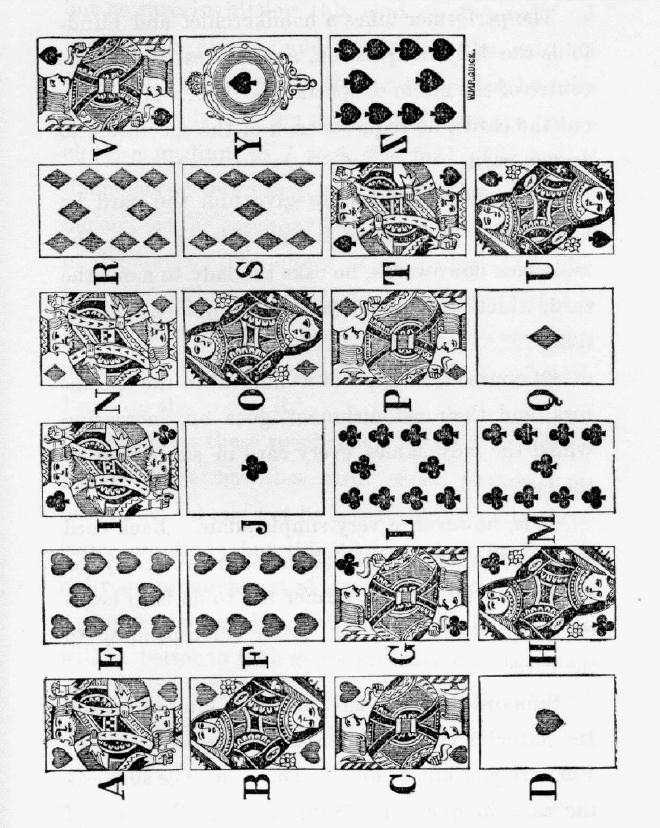 [Description: Illustration. Layout of cards
for blindfold trick]
[Description: Illustration. Layout of cards
for blindfold trick]The performer takes a handkerchief and blindfolds the lady in question, and places her in the centre of the circle of spectators. Then spreading out the cards, he requests each of the spectators to draw a card.
He requests the first to give him the card he has drawn; he looks at it, and placing it on the table face downwards, he asks the lady to name the card, which she does instantly and without hesitation.
Of course this appears wonderful to the spectators, and their astonishment goes on increasing whilst the lady names every card in succession to the last.
It is, however, a very simple affair. Each card represents a letter of the alphabet, as we see by the figure, and all the performer has to do is to begin every question with the letter corresponding to the card.
Suppose the party has drawn the king of hearts. Its letter is A. The performer exclaims — `Ah! I'm sure you know this!' The A at once suggests the card in question. Suppose it is the ace of
Doubtless these specimens will suffice to suggest phrases for every other card. Such phrases may be written out and got by heart — only twenty-three being required; but this seems useless, for it does not require much tact at improvisation to hit upon a phrase commencing with any letter. However, it will be better to take every precaution rather than run the risk of stopping in the performance, whose success mainly depends upon the apparently in-spired rapidity of the answers. The performer might conceal in the hollow of his hand a small table exactly like the figure, to facilitate his
15. The mystery of double sight.
All the cards of a pack, or indeed any common object touched by a spectator, may be named by an assistant in the following way — whilst in another apartment, or blindfolded.
Take 32 cards and arrange them in four lines, one under
the other. You arrange with your assistant to name the first
line after the days of the week; the second will represent
the weeks, the third the months, the fourth the
years. The assistant is enjoined to count the days aloud,
and the first card by the left. The following is the entire
scheme: —
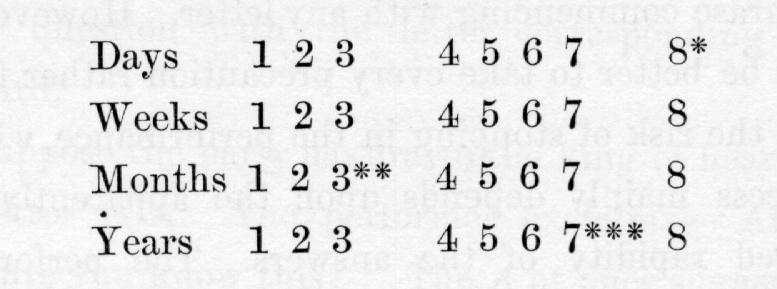 [Description: Scheme for double sight trick]
[Description: Scheme for double sight trick]
The cards being thus arranged, the party who has to guess them retires from the room. When
Suppose the card touched be one of those marked with the asterisks * ** ***; if it be the first, the associate says,; I give him eight days to guess it.' Then the medium, beginning with the upper line, that of the days, will at once be able to say that the card touched is the eighth of the first horizontal line, or the first of the eighth vertical line.
If it be the card holding the place of the number marked with two asterisks ** the associate says `three months,' and `seven years' for the one marked with three asterisks ***.
Thus, whatever card is touched, it will be easy to indicate it, by beginning with the line of days at the top, counting one from the left of the associate and medium.
Such is the simple process; and the following is the conventional catechism adopted by all the
With this collection of words and phrases, every existing object can be guessed, provided care be taken to classify them according to the following indications.
To operate, two persons must establish a perfect
understanding between them. One undertakes the questions, the
other the answers, the latter having his eyes perfectly
blindfolded. Both of them must thoroughly know the following
numbers with their correspondences: —
- 1. Now.
- 2. Answer or reply.
- 3. Name.
- 4. What is the object, or thing.
- 5. Try.
- 6. Again.
- 7. Instantly.
- 8. Which?
- 9. Quick.
- 10. Say.
- 20. Tell me.
- 30. I request you.
- 40. Will you.
- 50. Will you (to) me.
- 60. Will you (to) us.
Example: — Add the question of the simple number to the question of the decade or ten. Thus, in pronouncing the words `Say now,' 11 — for say is 10, and now is 1, total 11. This, therefore, forms question 11.
Again — `Tell me which number,' 28 — for `tell me' is 20, and `which' is 8, total 28.
Thirdly: — `I request you instantly,' 37; for `I request you' is 30, and `instantly' is 7, total 37.
All the expressions or words that follow are totally independent of the answer, and are only adapted to embellish or mystify the question as far as the audience is concerned. For instance:
Question 7. Instantly, what I have in my hand? Answer, A watch.
Question 9. Quick, the hour? Answer, nine o'clock.
Question 30, I request you (2) reply — the minutes. Answer, 32 minutes, that is 30 and 2, equal to 32.
It would be useless to give the entire correspondence invented for this apparently mysterious revelation, as a few specimens will suffice to show the principle. Say what I hold? A handkerchief. Say now what I hold? A snuff-box. Say, reply, what I hold? A pair of spectacles. Say and name what I hold? A box. Say and try to say what I hold? A hat. Say quickly what I hold? An umbrella.
It is obvious, from the preceding specimen, that a conventional catechism involving every object can be contrived by two persons, and adapted to every circumstance. The striking performances of the most notorious mesmeric `patients' in this line prove the possibility of the achievement. The `agent' who receives the questions in writing or in a whisper thus communicates the answer to the patient, who is laboriously trained in the entire encyclopædia of `common things' and things generally known; but it may happen that the question proposed by the spectator has been omitted in the scheme.
On one occasion, when the famous Prudence was the `patient,' and was telling the taste of all manner of liquids from a glass of water, I proposed `Blood' to the `agent.' He shook his head, said he would try; but it was useless. She said she `couldn't do it,' and the agent frankly admitted that it was a failure.
Now, if the mesmeric consciousness were really, as pretended, the result of mental intercommunication between the agent and patient, it is obvious that the well-known taste of blood could be communicated as well as any other taste. This experi
Should it happen that a spectator has discovered the method, the performers easily turn the tables against him. They have always ready a conventional list of common things; and the agent undertakes that his mesmeric patient will indicate them without hearing a word from him, even in another apartment. The agent then merely touches the object, and the patient begins with the first name in his list. The patient takes care to give the agent sufficient time, lest he should name the object next to be touched before the agent applies his finger, and thus, as it were, call for it rather than name it when touched, as required by the case.
16. Guessing.
Five persons having each thought of a different card, to guess five cards.
Take twenty-five cards, show five of them to a party, requesting him to think of one, then place them one upon the other. Proceed in like manner with five more to a second party, and so on, five parties in all, placing the fives on the top of each
Of course five persons are not necessary. If there be but one person, the card must be the first of the lot he points to.
It would be more artistic, perhaps, if you dispense with seeing the cards, making the lots up with your eyes turned away from the table. Then request the parties to observe in which lot their respective card is, and, taking the lots successively in hand, present to each the card thought of without looking at it yourself.
17. The Arithmetical Puzzle.
This card trick, to which I have alluded in a previous page, cannot fail to produce astonish
Hand a pack of cards to a party, requesting him to make up parcels of cards, in the following manner. He is to count the number of pips on the first card that turns up, say a five, and then add as many cards as are required to make up the number 12; in the case here supposed, having a five before him, he will place seven cards upon it, turning down the parcel. All the court cards count as 10 pips; consequently, only two cards will be placed on such to make up 12. The ace counts as only one pip. He will then turn up another, count the pips upon it, adding cards as before to make up the number 12; and so on, until no more such parcels can be made, the remainder, if any, to be set aside, all being turned down.
During this operation, the performer of the trick may be out of the room, at any rate, at such a distance that it will be impossible for him to see the first cards of the parcels which have been turned down; and yet he is able to announce the number of pips made up by all the first cards laid down, provided he is only informed of the number
The secret is very simple. It consists merely in multiplying the number of parcels over four by 13 (or rather vice versâ), and adding the remaining cards, if any, to the product.
Thus, there have just been made up seven packets, with five cards over. Deducting 4 from 7, 3 remain; and I say to myself 13 times 3 (or rather 3 times 13) are 39, and adding to this the five cards over, I at once declare the number of pips made up by the first cards turned down to be 44.
There is another way of performing this striking trick. Direct six parcels of cards to be made up in the manner aforesaid, and then, on being informed of the number of cards remaining over, add that number to 26, and the sum will be the number of pips made up by the first cards of the six parcels.
Such are the methods prescribed for performing this trick; but I have discovered another, which although, perhaps, a little more complicated, has the desirable advantage of explaining the seeming mystery.
Find the number of cards in the parcels, by subtracting the remainder, if any, from 52. Subtract the number of pip cards therefrom, deduct this last from the number made up of the number of parcels multiplied by 12, and the remainder will be the number of pips on the first cards.
To demonstrate this take the case just given. There are seven parcels and five cards over. First, this proves that there are 47 cards in the seven parcels made up of pips and cards. Secondly, subtract the number of pip cards — seven from the number of cards in the parcels; then, 7 from 47, 40 remain (cards). Thirdly, now, as the seven parcels are made up both of the pip cards and cards, it is evident that we have only to find the number of cards got at as above, to get the number of pips required. Thus, there being seven packets, 7 times 12 make 84; take 40, as above found (the number of cards), and the remainder is 44, the number of pips as found by the first method explained, — the process being as follows: — 52 -5 =47 -7 =40. Then, 7 x 12 =84 -40 =44.
In general, however, the first method, being the
18. To get a card into a pack firmly held by a party.
This trick strikingly shows how easily we may all be deceived by appearances.
Select the five or seven of any suit, say the seven of hearts, and handing the remainder of the pack to a party, show him the card, with your thumb on the seventh pip, so as to conceal it, saying: — `Now, hold the pack as firmly as you can, and keep your eye upon it to see that there is no trickery, and yet I undertake to get into it this six of hearts.' This injunction rivets his attention, and doubtless, like other wise people destined to be deceived, he feels quite sure that nobody can `take him in.' In this satisfactory condition for the operation on both sides, you flourish the card so as just to reach the level of the top of your hat (if you wear an Alpine scolloped, so much the better), and then, bringing down the card, rapidly strike it on the pack twice, uttering the words one, two, at each stroke; but, on the third raising of the card, leave it on the top of your hat, striking the pack with your hand — with the word three.
This trick may be performed in a drawing-room, if the
operator be seated, dropping the card behind his back, especially
in an easy-chair.
THE END.
| The gaming table : its votaries and victims, in all times and countries,
especially in England and in France. Vol. 2 | ||